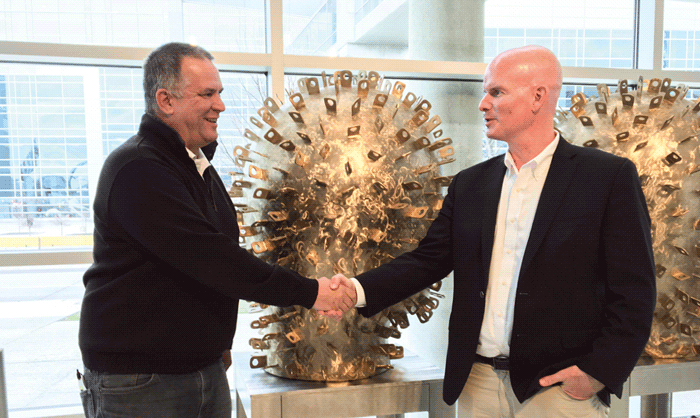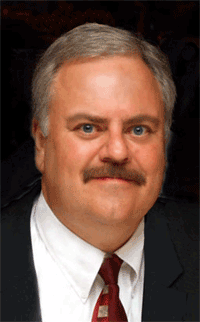Jan Faassen
Sales Director,
GKN Off-Highway Powertrain, Redditch, Worcestershire
John Anderson
President,
JCA Electronics, Winnipeg, Man.
Pictured Above: “There really is a need for those innovative implement manufacturers to be a part of the process, and to be able to have their equipment on the dealer’s lots, just like the mainline companies have,” John Anderson, (right) of JCA Electronics, tells Jan Faassen (left) of GKN Off-Highway Powetrain. The pair discusses the need for standardization — through the whole supply chain — for preventative diagnostics in their one-on-one in Omaha.
Jan Faassen: With this electrification, I think everybody’s going in different directions, and it seems like a lot of people are doing different things. Do you see some standards?
John Anderson: Yeah, and certainly there are standards being established, such as the ISOBUS protocol, which is something that’s been around for a while and evolving. But its challenge is keeping up with technology, as fast as that advances. We get into it in a big way, the introduction of smart devices into either the monitoring or control of actual ag equipment. When you have to integrate to a combine, tractor or a sprayer, that integration is usually the biggest challenge. But as I mentioned, things in farming are changing. The tractor in 10 years may be a totally different kind of drive unit. And we’re seeing that already. So, what we’re finding is the intelligence is moving from the tractor, from the combine, from the sprayer, actually to the implement. That decision making, that data collection, is actually being found more and more on that implement. And then that communication is going from the implement to the tractor, or the drive unit to turn the PTO on or off, to do all these different actions to guide that implement in the proper way, to drive efficiency on the field, or to drive less downtime, or all those types of things.
Faassen: In terms of standards or uniformity, it seems like there’s a lot of people in the game. And it’s kind of like VHS or Beta. Nowadays you’ve got DVDs or Bluray, or MP3s. There’s so much different technology, and it’s developing fast. Do you think that we’ll come to a real standard that everybody’s going to follow?
“When you talk about downtime for a farmer, he’s got to get his crop out, the weather just right, and if something’s not functioning and you could predict that it’s not going to function, that’s powerful…”
– Jan Faassen
Anderson: In the past, it’s always been each individual company, whether that’s a mainline company or shortline company, they’re trying to do it all themselves, to integrate their piece of equipment into everything they need to, and truly develop an advantage in some way to be able to sell more of their product than their competitors and so on. But as the technology gets more complex, with more need for integration into other devices or communication between devices, there is a real need, even by the mainline companies, to work with other companies to develop standards or develop technologies.
Faassen: But you have the vision of where you want to be, it’s a matter of coming up with the means to get there.
Anderson: Every step we take in adoption of technology, whether that be sensors or whatever it might be, we have to prove ourselves to show this is a step forward. It’s going to be cost effective, it’s going to be reliable, it’s going to be robust, and it’s going to be serviceable. It’s going to be understandable. When you talk about implements, farmers want to be able to fix those themselves. And dealers need to be able to support it. For the OEM ... the exciting part is that it isn’t just designing the right piece of equipment and getting it out there. You’re also integrating data, you’re also collecting data that can be accessed by either the OEM, the dealer or even us to monitor how that piece of equipment is working.
As it gets more complex, it’s more important that the integration of all levels of operation — again, farmer, dealer, OEM — be tied in to the operation. You think about it, and it’s not that far away where the dealer is actually monitoring equipment being used and receiving signals that say, “Hey, this PTO — or whatever it might be — has gone through so many percent of its cycle before it needs to be replaced,” so that you can start planning a week out. When that farmer is getting to that point, you’re arriving with the PTO before he ever needs to know about it.
“As it gets more complex, it’s more important that that integration of all levels of operation — again, farmer, dealer, OEM — be tied in to the operation…”
– John Anderson
Faassen: Sure, or to grease it or replace the friction discs in the clutch. I find it interesting, no matter what you want to make; there’s going to be a farmer that can break it, somewhere in the world. It’s just part of our industry. But what’s nice about what you’re proposing, and is being developed, is that now we’ll be able to tell how they did it in real time, live almost really, and predict it. And that’s a really powerful thing. When you talk about downtime for a farmer, he’s got to get his crop out, the weather just right, and if something’s not functioning and you could predict that it’s not going to function, that’s powerful.
Like you said, the equipment got bigger, it got huge, 800, 900 horsepower. Those small farms, they have smaller tractors, and they babied their equipment. Again, now you’ve got huge tractors and you have different dynamics on the equipment. And for all the reasons that you cited, wanting the predictability of the uptime, the maintenance, those are all the things that we see as important to our future, which is why we’re also looking at how do we apply sensors. Sensors tell us how many rotations a shaft has had, and how much load and wear-and-tear that the shaft has seen in order to give us great predictability for failure, and even more so on gearboxes.
A sensor that tells you if the oil’s clean or not. Farmers like to grease everything, and in some cases on drive shafts, we’ve come to lube for life features. When you have a lube for life feature, and then all of a sudden you put grease on it once a week, and you’re putting dirt in there, it kind of kills what was really a great feature to start. So looking ahead, having the predictability would enhance the equipment tremendously for our customers.
Anderson: And to standardize that, such that you aren’t an independent organization making equipment that’s not going to have to integrate into a lot of other equipment. Your equipment is going to have to integrate into so many other things and you have to think about that bigger picture to be successful.
Faassen: I’ve met a lot of people in our industry that were farmers, came up with great ideas, and that led them into the implement business and they stepped into that. I think that the large OEMs and the smaller implement manufacturers are also seeing it, so it’s good to be a part of something that’s being born.
Anderson: This is coming, and there’s a need for it. Let’s just make sure we get there in the right way that I could afford it, that it could be truly valuable to me and that we don’t have 100 different companies trying to do their own thing, and I’m having to buy or choose one of them. And the mainline companies have their own interests to selling as much equipment as they can and keeping one color on a farm. But there really is a need for those innovative implement manufacturers to be a part of the process, and to be able to have their equipment on the dealer’s lots, just like the mainline companies have.
It’s an interesting process we’re going through, but it’s going to involve a lot of different players like it always has, but working together as opposed to working as independent companies. I look forward to that challenge.







